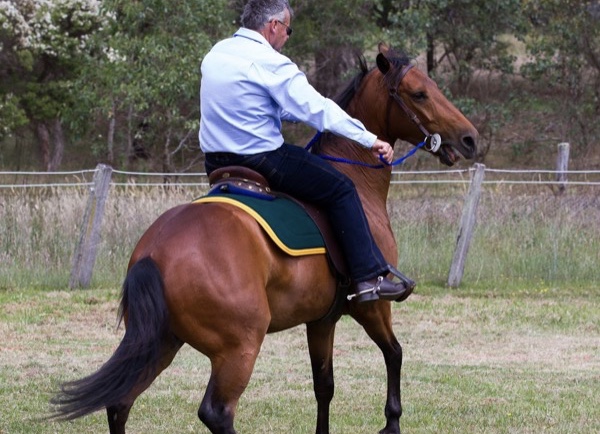Question from a reader:
“I’ve owned my 6-year-old warmblood-cross gelding for three years, and he has recently started to get really nappy when I ride him (although not always).
He will stop out of the blue, sometimes rears or bucks a little, and refuses to go forward.
I’ve ridden horses for many years, and I cannot think of how to get him past this behaviour.
When I turn him around and try to go the other direction, he still stops and refuses to walk on.
I have tried turning him in circles, getting off and walking him forward (which he does willingly), and then getting back on, all to no avail.
I’ve tried using spurs and a crop to encourage him, but he will not budge.
What could be causing this behaviour and how do I fix it?”
Vicky.
My response:
Hi Vicky,
It sounds like your horse has learned to stop and resist, rather than move forward and give when you ask.
Horses often learn to relieve pressure by resisting, rearing, kicking up and bucking.
Your horse must learn that bucking and rearing won’t relieve pressure from his rider.
At the moment, when he rears or bucks, you’re too busy hanging on to use your crop or spurs.
So from your horse’s point of view, his rearing and bucking makes your crop and spurs go away.
Overcoming your problem is quite simple in theory – your horse must learn that the only way to relieve pressure is to move forward and give.
Unfortunately, it’s not easy to put this theory into practice.
Your problem starts the very moment that your horse moves one step faster or slower than you ask, or moves one step off the line that you want to ride on.
Like everything else, you must come back to basics.
Ride your horse in an arena or a small area, where everything is to your advantage.
You must have an exact plan of where you want your horse to move.
You must also have an exact plan of the gait and the speed you want him to move.
You can’t truly control any horse until you have an exact plan of these three things.
Start by trotting a twenty metre circle.
You must correct your horse immediately he speeds up, slows down or moves off line.
If you have to correct him twenty times in twenty metres, that’s okay.
If your horse tries to stop, rear or buck, immediately pull him around in a tight circle, so that resisting is an unpleasant experience for him.
Remember that you’re not punishing your horse.
You’re simply showing him that it’s easy and pleasant to do as you ask and slightly unpleasant for him when he resists.
See this demonstrated in my Fear-free Fundamentals Online Clinic
The only way to overcome your problem is to be more definite than your horse.
Stay in the arena or small area for at least a couple of weeks.
When you have some improvement at the trot, move into a canter and concentrate on exactly where you want your horse to move and the speed you want him to move.
Make sure you have complete control before you ride outside.
At the moment, your horse knows that if he resists for long enough, you will (unintentionally) relieve the pressure.
You have to teach your horse that you relieve pressure only when he moves forward and gives.
Every time your horse speeds up or moves off line, you must correct him, and every time he resists, you must make life a little unpleasant for him by pulling him around in a tight
circle.
When your horse concentrates on where you want to move, the speed you want to move and the gait you want to move in, all your problems are over.

